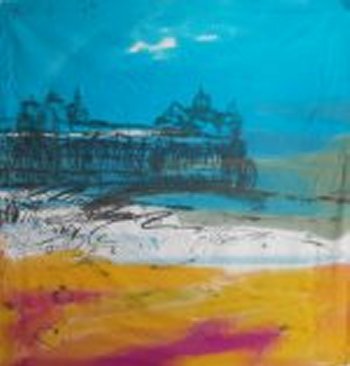


I start off by going to visit a location, and taking a large set of photographs with two different cameras. I take hundreds and hundreds of photographs throughout the day on location, getting to understand the landscape, and seeing it in various lights and preferably at different times of the day. I will take shots of the same scene from multiple different angles, and also take samples of earth and sands to remind myself of colours, as well as note-taking photos of textures. I build up a reference library of images.
I then go back to the studio, and look at the images on the computer. The ones that jump out of me as being what it was like it was when I was on the spot are ones that interest me, and I print them off on A4 paper to work on. I always work from one single image, I don't pick and choose elements, although I sometimes join shots together to make a panorama.
Although I sometimes paint from quickly-taken photographs of a fleeting moment or a quickly observed scene, on the whole I prefer to paint very well known areas, which I am completely familiar with. I will return to the same place again and again, such as the same places in Northern Ireland on the same weekend year after year, or to favourite beaches or glens. This is not to repeat scenes, or to copy or replicate - this is an exercise in releasing yourself from merely recording. If you know a place so well that you recognise individual plants, then you are released from getting caught up in the detail of mere replication, and can move towards an understanding the mood of the painting, the colour interplay, the rhythm of the landscape, and can experiment with texture and light and colour. It is a way of building on your understanding of a place, of adding depth, and of pushing yourself in terms of technique.
This exploration of motifs has been done by many artists as a way of refining their practice - Cezanne's panitings of Mont St Victoire, Monet's series of Rouen Cathedral, waterlilies or haystacks, Van Gogh's paintings of Mme Ginoux, or sunflowers, Joan Eardley's drawings of the Samson children.
You can read more about this process on my blog in this article 'Painting a Painting' HERE. There are lots of articles to explore on my blog, which will tell you about my palette, materials, brushes and palette knives.
Here are some examples of preparatory work that I do back in the studio when exploring a subject.
One of my favourite motifs is that of Eastbourne Pier, which I've known since childhood, and have painted, drawn and photographed thousands of times. Some are collage,others are textiles, some are on wooden panels. All are means, using other mediums and substrates, to explore the textures that are created in the final paintings using oil paint on linen canvas. I have even drawn the pier using some of the burnt timbers of the pier gathered from the fire which destoyed part of it a couple of years ago.

Eastbourne Pier
oil on canvas
36" x 36"

Four Studies of Eastbourne Pier (1)
mixed media on unprimed board
7" x 10"

Four Studies of Eastbourne Pier (2)
mixed media on unprimed board
7" x 10"

Four Studies of Eastbourne Pier (3)
mixed media on unprimed board
7" x 10"

Four Studies of Eastbourne Pier (4)
mixed media on unprimed board
7" x 10"

Eastbourne Pier: Night
screenprint and procion dye on textile
35" x 35"

Eastbourne Pier: Day
procion dye on textile
35" x 35"

Eastbourne Pier: Dawn
screenprint and procion dye on textile
35" x 35"

Eastbourne Pier: Dusk
screenprint and procion dye on textile
35" x 35"